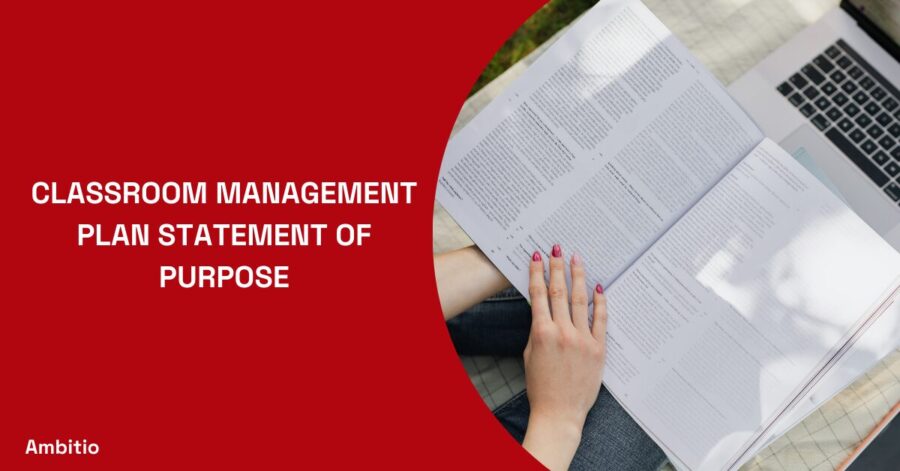14 December 2024
6 minutes read
Crafting a Classroom Management Plan Statement of Purpose

In the dynamic world of education, a classroom management plan stands as the backbone of a productive, respectful, and engaging learning environment. It’s a compass that guides not only students’ behaviors but also the pedagogical strategies that facilitate a space conducive to academic and social growth.
The crafting of a classroom management plan with an integral statement of purpose is a deliberate process that transforms the educational experience. This blog will unpack the elements of a well-defined classroom management plan statement of purpose and the steps to construct one effectively.
The Heart of Classroom Harmony: A Management Plan Statement of Purpose
The Role of a Statement of Purpose in Your Classroom Management Plan
The statement of purpose in your classroom management plan is not merely a formal document—it’s the embodiment of your classroom’s ethos, the values you aspire to instill in your students, and the behavioral standards set for the academic year.
It transcends a mere list of dos and don’ts, encapsulating a narrative that resonates with each learner, guiding them to internalize and understand the class rules’ rationale.
The Philosophy Behind the Purpose
A statement of purpose goes beyond ensuring compliance with classroom rules. It articulates the philosophical underpinnings of your educational approach. It should echo the larger educational goals of fostering critical thinking, encouraging curiosity, and building a community of learners who support and inspire each other. When students understand the ‘why’ behind the ‘what’, they are more likely to engage positively with the class’s expectations.
Crafting Your Statement of Purpose
The statement of purpose should begin with a reflection on what you believe to be the foundational elements of a conducive learning environment. Ask yourself questions like:
What behaviors are non-negotiable in promoting a safe and productive classroom? How can you create an atmosphere that celebrates learning and respects individual differences? This reflection becomes the soul of your classroom management plan, steering all subsequent decisions and strategies.
Communicating the Purpose
Once articulated, this purpose must be communicated effectively at the beginning of the year and reinforced regularly. It should be clear, concise, and accessible to not just students, but also their families. This clarity ensures that everyone in the educational ecosystem understands the expectations and works collaboratively towards maintaining them.
Crafting an Inclusive Environment Through Purposeful Management
Creating a Safe and Supportive Atmosphere
An inclusive classroom environment recognizes and accommodates the diverse needs of students. A classroom management plan that is grounded in respect, empathy, and fairness sets the stage for all students to thrive.
The statement of purpose should emphasize the commitment to creating a space where every student feels valued and has the opportunity to contribute meaningfully to the classroom community.
Behavior Management: A Spectrum of Strategies
When considering behavior management, it is crucial to adopt a spectrum of strategies that cater to various scenarios and student needs. These strategies might range from clear, consistent expectations to individualized support plans for students who may struggle with traditional classroom settings.
An inclusive statement of purpose recognizes that behavior management is not one-size-fits-all and commits to finding the best path forward for each student.
The Power of Positive Reinforcement
Positive reinforcement should be a cornerstone of any classroom management plan. Recognizing and rewarding good behavior and academic effort is often more effective than focusing solely on punitive measures for misbehavior.
When students feel that their positive contributions are seen and valued, they are more likely to repeat those behaviors and take ownership of their learning process.
Strategies for Effective Classroom Management
The Importance of Clear Rules and Expectations
From the first day, students should be clear on what is expected of them. Rules should be simple, precise, and, most importantly, enforceable. They should be displayed prominently in the classroom, discussed, and agreed upon. By involving students in the creation of these rules, you foster a sense of ownership and responsibility.
Consistency is Key
Consistency in enforcing rules and procedures is vital. Inconsistent application can lead to confusion and a lack of respect for the rules. Teachers must be diligent in applying the rules uniformly to all students, providing a stable framework within which all students can operate.
Engaging Students in the Process
Engagement is not just about keeping students busy; it’s about involving them deeply in the learning process. Teachers should strive to create lessons that are not only informative but also interactive and relatable. When students are engaged, there is less room for disruption and more space for meaningful learning.
Resources and Tools for Developing Your Management Plan
Online Resources
In the digital age, there are numerous online resources available to assist in developing your classroom management plan. From templates to sample statements of purpose, these resources can provide a solid starting point for creating a plan that resonates with your educational philosophy.
Collaborative Tools
Don’t underestimate the power of collaboration when developing your classroom management plan. Tools like online forums, professional networks, and educational communities can offer support, advice, and feedback as you craft and refine your plan.
Professional Development Opportunities
Lastly, consider professional development opportunities that focus on classroom management. These can offer new insights, strategies, and perspectives that enrich your approach and ensure your classroom management plan remains dynamic and effective.
Designing Your Classroom Management Plan: A Step-by-Step Approach
Step 1: Defining Your Classroom’s Mission
Begin by articulating the overarching mission of your classroom. This is the lodestar that will guide every aspect of your classroom management plan. Consider what you aim to accomplish, not just in terms of academic achievement but also in creating a community of learners.
Step 2: Establishing Classroom Rules
Next, develop a clear set of classroom rules that support your mission statement. These rules should be developed collaboratively with your students, giving them a voice in how their classroom operates.
This collaborative approach not only fosters a sense of community but also helps ensure that students are more invested in following the rules they helped create.
Step 3: Creating a Behavior Management Strategy
Consider how you will address behavior in your classroom. What will be your approach to discipline? How will you reward good behavior? A well-rounded strategy will include elements of both, ensuring that students know the consequences of misbehavior and the rewards for upholding the classroom’s standards.
Step 4: Communicating with Stakeholders
A successful classroom management plan requires buy-in from all stakeholders, including students, parents, and other staff members. Make sure your plan is communicated clearly to all involved, and that everyone understands their role in supporting it.
Step 5: Monitoring and Adjusting
Finally, be prepared to monitor the effectiveness of your classroom management plan and make adjustments as necessary. No plan is perfect from the start, and flexibility is key to addressing the changing dynamics of your classroom.
The Classroom Management Plan in Action: Real-Life Applications
Daily Routines and Procedures
A classroom management plan is not static; it’s a living document that comes to life in the daily routines and procedures of the classroom. For instance, how students enter the classroom, transition between activities, and manage their materials can all be guided by the principles outlined in your management plan. Establishing and practicing these routines early in the school year can help prevent many behavioral issues before they start.
Addressing Challenges Proactively
Challenges will arise, but a robust classroom management plan equips teachers to address them proactively. This might involve having a quiet space for students to regroup, strategies for de-escalating conflicts, or individualized behavior charts. By anticipating potential issues and having strategies in place, teachers can manage them more effectively.
Building Relationships with Students
At the heart of effective classroom management is the relationship between teacher and student. When students feel respected and understood, they are more likely to respect the rules of the classroom.
Take time to build rapport with your students, understand their individual needs and strengths, and show that you care not just about their academic success but also about their well-being.
Reflecting and Evolving: The Cycle of Classroom Management
The Role of Reflection in Classroom Management
Reflection is a powerful tool for any educator. Regularly taking stock of what is and isn’t working in your classroom allows you to make informed decisions about how to adjust your management plan. This might involve individual reflections, student feedback, or discussions with colleagues.
The Evolution of Your Management Plan
As your students grow and change throughout the school year, so too should your classroom management plan. Be open to evolution and change, understanding that flexibility can lead to better outcomes for your students.
Celebrating Successes
Don’t forget to celebrate the successes, no matter how small. Recognizing the positive outcomes of your classroom management plan not only reinforces good behavior but also boosts morale and encourages a culture of achievement and respect.
Conclusion
A classroom management plan with a clear statement of purpose is not just a document—it’s a manifesto that declares the intentions, values, and educational goals of a classroom.
It sets the tone for the school year, underpins the learning environment, and provides a framework within which students can flourish. By crafting a plan that is thoughtful, inclusive, and flexible, educators can establish a classroom atmosphere that is conducive to learning, respectful interaction, and personal growth for every student.
FAQs
Can I find a sample classroom management plan online for free?
Yes, there are many resources online that offer sample classroom management plans for free. These can serve as a template to help you create a tailored plan that meets the unique needs of your classroom.
How do I involve students in creating the classroom management plan?
Involve students by asking them to contribute ideas for classroom rules, discussing the purpose behind each rule, and explaining how these rules facilitate a better learning environment for everyone.
How often should I review and modify the classroom management plan?
Reviewing the plan periodically, such as at the end of each term, can be effective. However, be ready to make adjustments as needed throughout the school year to address any new challenges or changes in the classroom dynamic.
How can a classroom management plan statement of purpose help with student learning?
A clear statement of purpose helps students understand the expectations and the reasons behind them, which can lead to better engagement, fewer disruptions, and a more respectful and productive classroom environment.
What are some strategies for implementing the classroom management plan?
Some strategies include clear communication of the plan, consistent enforcement of rules, use of positive reinforcement, regular reflection and adaptation of the plan, and involving parents or guardians in the process.

You can study at top universities worldwide!
Get expert tips and tricks to get into top universities with a free expert session.
Book Your Free 30-Minute Session Now! Book a call now




























